
J. L. Boone, Ph.D., Ecology
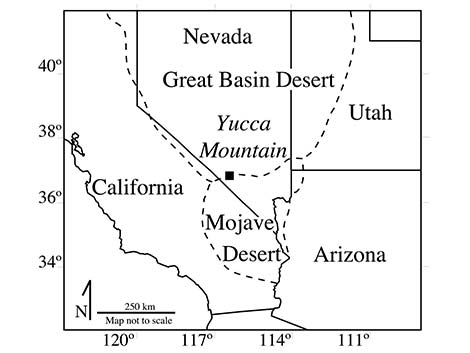 Yucca Mountain (square black dot) is located in southern Nevada in the transition zone between the Mojave and Great Basin Deserts |
I came to Nevada to work as an Animal Ecologist for Bechtel SAIC Company, LLC (BSC) on the US Department of Energy Yucca Mountain Project (YMP) in 1995. BSC was a company formed by Bechtel and Science Applications International Corporation (SAIC) to manage the Yucca Mountain Project. I stayed until 2006, and the project was shut down by the U.S. Congress in 2010. Yucca Mountain is located about 90 miles northwest of Las Vegas, Nevada, on the western edge of the Nevada Test Site. This was an area of national interest because it was being considered as a site for the permanent underground storage (repository) for high-level nuclear waste. This was an area of environmental interest because it is located in the little-studied transition zone between the hot and dry Mojave Desert to the south and the cold and dry Great Basin Desert to the north. |
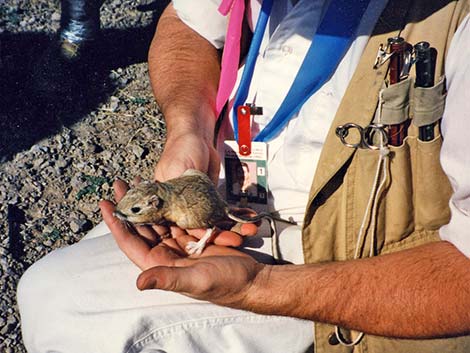 Releasing a live-trapped Merriam's kangaroo rat |
As a vertebrate ecologist, I had two main roles on the YMP. First, I participated in the environmental monitoring program by collecting, analyzing, and publishing data concerning vertebrate populations (mammals, reptiles, and birds) and the impacts of the YMP on them. My second role was, as an ecologist, to participate on a large interdisciplinary team of scientists trying to find a solution to the national problem of the safe and permanent disposal of high-level nuclear waste. The ecology projects ended in 1999, but I stayed on the project as a technical editor, mostly helping geologists, hydrologists, and engineers write reports. After working as an ecologist for several years, the ecology budget was cut to the point where virtually everyone was laid off, but because I could put words to paper, I was transferred to the technical editing group. I spent several years working with the hydrology and biosphere projects helping to write reports. When even that work was finished, I switched to the engineering group. |
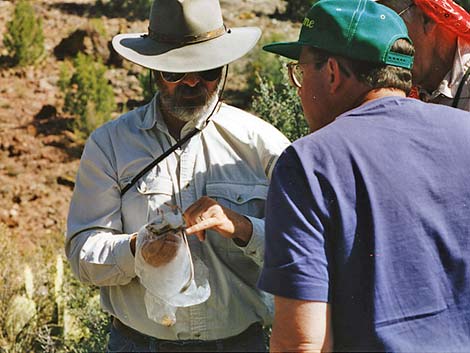 |
As one in a team of ecologists, we studied vertebrate populations and vegetation to determine whether construction activities at the YMP negatively affected the environment. In effect, we were the environmental watchdogs ensuring that DOE was conducting its activities in an environmentally sensitive manner. To do this, we studied lizard, small mammal, and desert tortoise populations primarily using capture, mark, release, and recapture techniques. We also conducted a large radiotelemetry study of tortoise movements and habits. All of this work was being done before radioactive material was brought to Yucca Mountain so that we would know what the environment was like before the repository was filled. They never did bring any radioactive material to the site. |
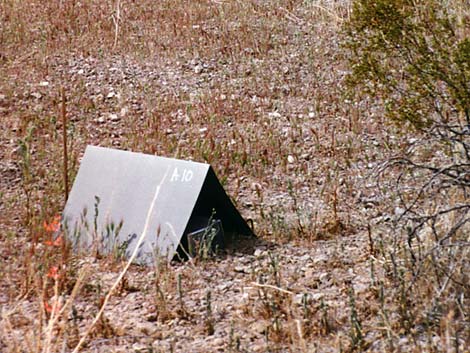 Live trap at Yucca Mountain. The tent shades the trap so the occupant wouldn't overheat and die. |
Specifically, our vertebrate studies concerned various aspects of population and community ecology, and the effects of humans on the populations and communities. I primarily looked at questions related to how many rodents (mostly kangaroo rats, Dipodomys, and pocket mice, Chaetodipus and Perognathus) and lizards (mostly side-blotched lizards; Uta stansburiana) were out there from season to season. We used this information to study recruitment and survival in relation to rainfall and the abundance of vegetation. Other than habitat lost to construction site, which was relatively small in the grand scheme of things, we found no negative effects of the YMP on vertebrate ecology. |
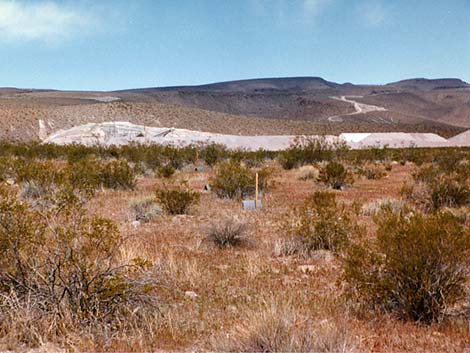 Trap grid adjacent to construction activity |
I was also involved in determining whether or not a radioactive-waste repository, as currently conceived and understood (i.e., underground geology, engineering design), would safely isolate radioactive waste from humans for at least 10,000 years, and possibly as long as 1,000,000 years. To do this, the YMP studied engineering design, geology, groundwater flow patterns, the effects of heat on underground rocks, earthquakes, and the above-ground environment at Yucca Mountain. |
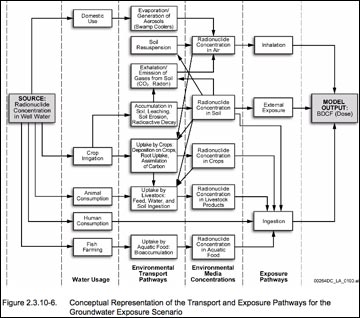 Conceptual model of the biosphere |
Computer modelers then used this data to determine how well the total system would perform. That is, how long would waste-package canisters last, and after they fail (we must assume that they would fail), how fast would radioactive material seep into the groundwater. Then, after the radioactive material gets in the groundwater, we modeled how fast these materials would move through the aquifer. Finally, the YMP asked the question: if someone drills a well into the contaminated aquifer, how much radiation would they get from drinking the water, from using the water to irrigate a farm, or from using the water in some other way? My part in this modeling effort was to help conceive and model the biosphere (the above-ground system where humans interact with the environment). In general, we worked from the assumption that people in 10,000 years would look and act substantially as we do today (what else can we assume?), and that future land-use practices would be similar to current land-use practices. We were, in effect, saying: "If someone buried radioactive material in Yucca Mountain 10,000 years ago, how would it affect us today?" |
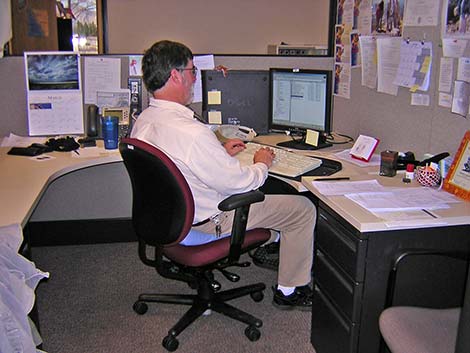 Hard at work on a report |
To answer this question, we modeled a family farm, and then varied parameters to include scenarios ranging from a subsistence farmer (someone who grows and eats only locally produced food) to a suburban resident (who may have a backyard garden, but buys most or all food from a store). In either case, we assumed that they would get their water from a contaminated well. We also set up the model so that we could include the effects of global climate change; that is, if rainfall patterns change, how would getting more or less rain affect the repository itself, and affect the biosphere? We determined that in only 10,000 years, there would be no effect of radiation on a farmer because the aquifer would not be contaminated in that short a time. Congress later instructed us to consider effects out to 1 million years, but I left before that work was done. |
| Other Stuff | Home |